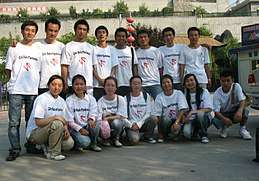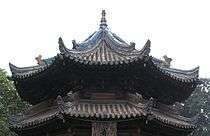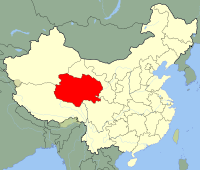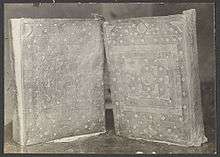Salar people
The Salar people (Chinese: 撒拉族; pinyin: Sālāzú; Salar: Salır) are a Turkic ethnic minority of China who largely speak the Salar language, an Oghuz language.
Salır (撒拉族) | |
|---|---|
 | |
| Total population | |
| 130,607 (2010 census) | |
| Regions with significant populations | |
| China: provinces of Qinghai, Gansu, Xinjiang | |
| Languages | |
| Chinese, Salar | |
| Religion | |
| Islam | |
| Related ethnic groups | |
| Other Turkic peoples |
| Part of a series on Islam in China | ||||||
|---|---|---|---|---|---|---|
 | ||||||
|
||||||
|
| ||||||
The Salar people numbered 130,607 people in the last census of 2010. They live mostly in the Qinghai-Gansu border region, on both sides of the Yellow River, namely in Xunhua Salar Autonomous County and Hualong Hui Autonomous County of Qinghai and the adjacent Jishishan Bonan, Dongxiang and Salar Autonomous County of Gansu and in some parts of Henan and Shanxi. There are also Salars in Northern Xinjiang (in the Ili Kazakh Autonomous Prefecture).
They are a patriarchal agricultural society and are predominantly Muslim.
History
Origin
According to Salar tradition and Chinese chronics, the Salars are the descendants of the Salur tribe, belonging to the Oghuz Turk tribe of the Western Turkic Khaganate. During the Tang dynasty, the Salur tribe dwelt within China's borders and lived since then in the Qinghai-Gansu border region.[1][2]
Islamic legend
According to a legend, two brothers Haraman and Ahman, possibly forefathers of the present day Salar tribe once lived in the Samarkand area. They were highly ranked at local Islamic mosques, which led to persecution from local rulers. The two brothers fled along with eighteen members of the tribe on a white camel with water, soil, and a Koran before heading east. The group trekked through the northern route of the Tian Shan mountain ranges into the Jiayuguan pass and passing through the present day Suzhou District, Ganzhou district, Ningxia, Qinzhou District, Gangu County, and eventually stopping at the present Xiahe County. Later, another forty people from Samarkand joined the group. The group passed through the southern route of the Tian Shan mountain ranges and entered Qinghai. They arrived at the present Guide County, and twelve of them settled there.[3][4]
The Koran, the two brothers brought on their journey to China is to this day still preserved in Xunhua at Jiezi Mosque.[5] The Nanjing Museum has repaired the Koran to protect it from decay.[6]
Ming dynasty
The Salar clan leaders voluntarily capitulated to the Ming dynasty around 1370. The chief of the four upper clans around this time was Han Baoyuan and the Ming government granted him office of centurion, it was at this time the people of his four clans took Han as their surname.[7] The other chief Han Shanba of the four lower Salar clans got the same office from the Ming government, and his clans were the ones who took Ma as their surname.[8] The ethnogenesis of the Salar started from when they pledged allegiance to the Ming dynasty under their leader Han Bao.[9] Han Bao's father was Omar, and Omar's father was Haraman, who led the Salars on their journey from Central Asia to China.[10]
The Kargan Tibetans, who live next to the Salar, have mostly become Muslim due to the Salars. The Salar oral tradition recalls that it was around 1370 in which they came from Samarkand to China.[11][12]
The Salars were permitted an enormous amount of autonomy and self-rule by the Ming dynasty, which gave them command of taxes, military, and the courts.[13]
The Ming and Qing dynasties often mobilized Salars into their militaries as soldiers, with the Ming government recruiting them at 17 different times for service and the Qing government at five different times.[14]
Qing dynasty
In the 1670s, the Kashgarian Sufi master Āfāq Khoja (and, possibly, his father Muhammad Yūsuf even earlier) preached among the Salars, introducing Sufism into their community.[15] In the mid-18th century, one of Āfāq Khoja's spiritual descendants, Ma Laichi, spread his teaching, known as Khufiyya among the Salars, just as he did among their Chinese-speaking and Tibetan-speaking neighbors.[16]
Throughout the 1760s and 1770s, another Chinese Sufi master, Ma Mingxin, was spreading his version of Sufi teaching, known as Jahriyya throughout the Gansu province (which then included Salar's homeland in today's Qinghai). Many Salars became adherents of Jahriyya, or the "New Teaching", as the Qing government officials dubbed it (in opposition to the "Old Teaching", i.e. both the Khufiyya Sufi order and the non-Sufi Gedimu Islam). While the external differences between the Khufiyya and the Jahriyya would look comparatively trivial to an outsider (the two orders were most known for, respectively, the silent or vocal dhikr, i.e. invocation of the name of God), the conflict between their adherents often became violent.[17]
Sectarian violence between the Jahriyya and Khufiyya broke out repeatedly until the major episode of violence in 1781.[18] In 1781, the authorities, concerned with the spread of the "subversive" "New Teaching" among the Salars, whom they (perhaps unfairly) viewed as a fierce and troublesome lot, arrested Ma Mingxin and sent an expedition to the Salar community of Xunhua County to round up his supporters there.[19] In the Jahriyya revolt sectarian violence between two suborders of the Naqshbandi Sufis, the Jahriyya Sufi Muslims and their rivals, the Khafiyya Sufi Muslims, led to a Jahriyya Sufi Muslim rebellion which the Qing dynasty in China crushed with the help of the Khafiyya Sufi Muslims.[20]
The Jahriyya Salars of Xunhua, led by their ahong (imam) nicknamed Su Sishisan ("Su Forty-three", 苏四十三), responded by killing the government officials and destroying their task force at the place called Baizhuangzi, and then rushed across the Hezhou region to the walls of Lanzhou, where Ma Mingxin was imprisoned.[19]
When the besieged officials brought Ma Mingxin, wearing chains, to the Lanzhou city wall, to show him to the rebels, Su's Salars at once showed respect and devotion to their imprisoned leaders. Scared officials took Ma down from the wall, and beheaded him right away. Su's Salars tried attacking the Lanzhou city walls, but, not having any siege equipment, failed to penetrate into the walled city. The Salar fighters (whose strength at the time is estimated by historians to be in 1,000-2,000 range) then set up a fortified camp on a hill south of Lanzhou.[19] Some Han Chinese, Hui, and Dongxiang (Santa) joined the Salar in the rebellion against the Qing.[21]
To deal with the rebels, Imperial Commissioners Agui and Heshen were sent to Lanzhou. Unable to dislodge the Salars from their fortified camp with his regular troops, Agui sent the "incompetent" Heshen back to Beijing, and recruited Alashan Mongols and Southern Gansu Tibetans to aid the Lanzhou garrison. After a three months' siege of the rebel camp and cutting off the Salars' water supply, Agui's joint forces destroyed the Jahriya rebels; Su and all his fighters were all killed in the final battle.[19] Overall, it is said that as much as 40% of their entire population was killed in the revolt.
As late as 1937, a folk ballad was still told by the Salars about the rebellion of 1781, and Su Sishisan suicidal decision to go to war against the Qing Empire.[22]
The Qing government deported some of the Salar Jahriyya rebels to the Ili valley which is in modern-day Xinjiang. Today, a community of a few thousand Salars speaking a distinct dialect of Salar still live there. Salar migrants from Amdo (Qinghai) came to settle the region as religious exiles, migrants, and as soldiers enlisted in the Qing army to fight rebels in Ili, often following the Hui.[23] The distinctive dialect of the Ili Salar differs from the other Salar dialects because the neighboring Kazakh and Uyghur languages in Ili influenced it.[24] The Ili Salar population numbers around 4,000 people.[25] There have been instances of misunderstanding between speakers of Ili Salar and Qinghai Salar due to the divergence of the dialects.[26] The differences between the two dialect result in a "clear isogloss".[27]
In the 1880s-1890s, sectarian strife was rife in the Salar community of Xunhua again. This time, the conflict was among two factions of the Hua Si menhuan (order) of the Khufiyya, and in 1895 the local Qing officials ended up siding with the reformist faction within the order. Although the factional conflict was evident not only in Salar Xunhua but in Hui Hezhou as well, the troops were first sent to Xunhua - which again precipitated a Salar rebellion, which spread to many Hui and Dongxiang communities of Gansu too.[28][29] It turned into the Dungan Revolt (1895), which was crushed by a loyalist Hui army.
The Hui people, also known as the "white capped HuiHui", used incense during worship, while the Salar, also known as "black capped HuiHui", considered this to be a heathen ritual and denounced it.[30]
Modern era
Like other Muslims in China, the Salars served extensively in the Chinese military. It was said that they and the Dongxiang were given to "eating rations", a reference to military service.[31]
During the Second Sino-Japanese War, Salar troops and officers served in the Qinghai army of the Muslim general Ma Biao, and they battled extensively in bloody battles against the Imperial Japanese Army in Henan province. In 1937, during the Battle of Beiping–Tianjin the Chinese government was notified by Muslim General Ma Bufang of the Ma clique that he was prepared to bring the fight to the Japanese in a telegram message.[32] Immediately after the Marco Polo Bridge Incident, Ma Bufang arranged for a cavalry division under Ma Biao to be sent east to battle the Japanese.[33] Salars made up the majority of the first cavalry division which was sent by Ma Bufang.[34] The Qinghai Chinese, Salar, Chinese Muslim, Dongxiang and Tibetan troops Ma Biao led fought to the death against the Japanese, or committed suicide refusing to be taken as prisoner. In September 1940, when the Japanese made an offensive against the Muslim Qinghai troops, they ambushed them and killed so many of them the Japanese soldiers that they were forced to retreat. The Japanese could not even pick up their dead, they instead cut an arm from their corpses limbs for cremation to send back to Japan. The Japanese did not dare make an offensive like that again.[35]
Han Youwen, a Salar general in the National Revolutionary Army and member of the Kuomintang (Nationalist Party), directed the defense of the city of Xining during air raids by Japanese planes. Han survived an aerial bombardment by Japanese planes in Xining while he was being directed via telephone from Ma Bufang, who hid in an air raid shelter in a military barracks. The bombing resulted in human flesh splattering a Blue Sky with a White Sun flag and Han being buried in rubble. Han Youwen was dragged out of the rubble while bleeding and he managed to grab a machine gun while he was limping and fired back at the Japanese warplanes. He later defected to the Communist People's Liberation Army, serving in numerous military positions and as vice chairman of Xinjiang. He had led Chinese Muslim forces against Soviet and Mongol forces in the Pei-ta-shan Incident.
Culture


The Salar had their own unique kinship clanships.[36] Matchmakers and parents arrange marriages among the Salar.[37] The Salar are an entrepreneurial people, going into multiple businesses and industries.[38] They practice agriculture and horticulture.[39] They cultivate chili and pepper in their gardens.[40] Buckwheat, millet, wheat, and barley are among the crops they grow.[2] Other important crops include melons, grapes, apples, apricots, and walnuts. A few Salar raise livestock and the local timber industry is also another source of income for some villages.[41]
Culturally they have strictly conformed to the Naqshbandi ways of their Hui coreligionists. Therefore, many nomadic Turkmen traditions have been lost, and Turkmen music was forbidden. More secular minded Salars have resorted to appropriating Tibetan or Moghol (a Qinghai Mongolic Muslim group) music as their own. The ethnic Salars of Qinghai celebrated on March 21, 2010 their first "Nowruz" in modern times, as a revived Turkmen holiday.
Hui general Ma Fuxiang recruited Salars into his army, and said they moved to China since the Tang dynasty. His classification of them is in two groups, five inner clans, eight outer clans. Ma said the outer group speaks Tibetan, no longer knowing their native language. Salars only married other Salars. Uighurs have said that they were unable to understand the Salar language.[42]
Ma and Han are the two most widespread names among the Salar. Ma is a Salar surname for the same reason it is a common Hui surname, Ma substitutes for Muhammad.[43][44] The upper four clans of the Salar assumed the surname Han and lived west of Xunhua.[45] One of these Salar surnamed Han was Han Yimu, a Salar officer who served under General Ma Bufang. He fought in the Kuomintang Islamic Insurgency in China (1950–1958), leading Salars in a revolt in 1952 and 1958.[46][47] Ma Bufang, enlisted Salars as officers in his army by exclusively targeting Xunhua and Hualong as areas to draw officers from.[48]
Clothing
The typical clothing of the Salar very similar to the Hui people in the region. The men are commonly bearded and dress in white shirts and white or black skullcaps. The traditional clothing for men is jackets and gowns.[39] The young single women are accustomed to dressing in Chinese dress of bright colors. The married women utilize the traditional veil in white or black colors.
Language

The people of China and Salar themselves regard the Salar language as a Tujue language (Turk language) (突厥語言).[51] The Salar language has two large dialect groups. The divergence is due to the fact that one branch in Xunhua county of Qinghai province and Gansu province was influenced by the Tibetan languages and Chinese, and the other branch in Ili Kazakh Autonomous Prefecture by the Uyghur and Kazakh languages.[52]
In the late 1990s, it was estimated that out of the some 89,000 Salars, around 60,000 spoke the Salar language.[53]
Most Salar do not use any written script for the Salar language,[40] instead they use Chinese characters for practical purposes.[50][54][55][56] Salar serves as their spoken language, while Chinese serves as a both spoken and written language.[57] Many of the current generation of Salars are fluent in Chinese.[58]
In Amdo (Qinghai), Salar language has heavy Chinese and Tibetan influence. Although of Turkic origin, major linguistic structures have been absorbed from Chinese. Around 20% of the vocabulary is of Chinese origin, and 10% is also of Tibetan origin. Yet, according to author William Safran, the official Communist Chinese government policy deliberately covers up these influences in academic and linguistics studies, trying to emphasize the Turkic element and completely ignoring the Chinese in the Salar language.[59] The Salar use the Chinese writing system, though they have their own written language which, however, is used by very few people. Salar language has taken loans and influence from neighboring Chinese varieties.[60] It is neighboring variants of Chinese which have loaned words to the Salar language.[61] In Qinghai, many Salar men speak both the Qinghai dialect of Chinese and Salar. Rural Salars can speak Salar fluently while urban Salars often assimilate into the Chinese speaking Hui population.[62]
In Ili Salar, the i and y high front vowels, when placed after an initial glides are spirantized with j transforming into ʝ.[63] Qinghai and Ili Salar have mostly the same consonantal development.[64]
Religion
Salars profess Sunni Islam (Hanafi Maturidites). In addition to their traditional places, they live, they live in cities, mainly inhabited by other Muslims - Dungans. Islamic Education Received at Gaizi Mişit Madrasah in Jiezi Village.[65]
Genetics
The Y-DNA haplogroups, and therefore the paternal genetic lineages of the Salar people, exhibit a mix of West Eurasian and East Asian haplogroups. Their maternal lineages are overwhelmingly East Asian.[66][67]
Literature
- Ma Jianzhong; Stuart, Kevin (1996). "'Stone Camels and Clear Springs': The Salar's Samarkand Origins". Asian Folklore Studies. 55 (2): 287–298. doi:10.2307/1178823. JSTOR 1178823.
- Ma Wei; Ma Jianzhong; Stuart, Kevin, eds. (2001). Folklore of China's Islamic Salar Nationality. Lewiston, New York: Edwin Mellen.
- Ma Wei; Ma Jianzhong; Stuart, Kevin (1999). "The Xunhua Salar Wedding". Asian Folklore Studies. 58 (1): 31–76. doi:10.2307/1178890. JSTOR 1178890.
- Lipman, Jonathan Neaman (1998). Familiar strangers: a history of Muslims in Northwest China. Hong Kong University Press. ISBN 978-962-209-468-0.
- Tenišev, E.R (1976). Stroj salarskogo âzyka [The structure of the Salar language]. Moscow: Nauka.
- Lin Lianyun (林莲云) (1992). 汉撒拉、撒拉汉词汇 [Chinese-Salar Salar-Chinese lexicon]. Chengdu: People's Press of Sichuan.
References





- Erdal, Marcel; Nevskaya, Irina, eds. (2006). Exploring the Eastern Frontiers of Turkic. Volume 60 of Turcologica Series. Otto Harrassowitz Verlag. p. xi. ISBN 978-3447053105. Retrieved 24 April 2014.
- "China's Minority Peoples - The Salars". Cultural-china.com. Cultural China. 2007–2014. Archived from the original on 5 October 2013. Retrieved 1 April 2013.
- Shoujiang Mi; Jia You (2004). Islam in China. 五洲传播出版社. p. 55. ISBN 978-7-5085-0533-6. Retrieved 2010-06-28.
- Totem Admiration in China's Ethnic Groups. CRIENGLISH.com. 2005-03-01.
- "Oldest handwritten Koran needs protection". China Daily. 2004-10-20. Retrieved 1 April 2013.
- "China restores oldest handwritten copy of Quran". China Daily. Xinhua. 2007-02-25. Retrieved 1 April 2013.
- William Ewart Gladstone; Baron Arthur Hamilton-Gordon Stanmore (1961). Gladstone-Gordon correspondence, 1851-1896: selections from the private correspondence of a British Prime Minister and a colonial Governor, Volume 51. American Philosophical Society. p. 27. Retrieved 2010-06-28.(Volume 51, Issue 4 of new series, American Philosophical Society Volume 51, Part 4 of Transactions Series Volume 51, Part 4 of Transactions of the American Philosophical Society new ser v. 51, no. 4)(Original from the University of California)
- William Ewart Gladstone; Baron Arthur Hamilton-Gordon Stanmore (1961). Gladstone-Gordon correspondence, 1851-1896: selections from the private correspondence of a British Prime Minister and a colonial Governor, Volume 51. American Philosophical Society. p. 27. Retrieved 2010-06-28.(Volume 51, Issue 4 of new series, American Philosophical Society Volume 51, Part 4 of Transactions Series Volume 51, Part 4 of Transactions of the American Philosophical Society new ser v. 51, no. 4)(Original from the University of California)
- Dwyer, Arienne M. (2007). Salar: A Study in Inner Asian Language Contact Processes, Part 1 (illustrated ed.). Otto Harrassowitz Verlag. p. 9. ISBN 978-3447040914. Retrieved 1 April 2013.
- Dwyer, Arienne M. (2007). Salar: A Study in Inner Asian Language Contact Processes, Part 1 (illustrated ed.). Otto Harrassowitz Verlag. p. 6. ISBN 978-3447040914. Retrieved 24 April 2014.
- Royal Geographical Society (Great Britain) (1894). The Geographical journal, Volume 3. London: Royal Geographical Society. p. 362. Retrieved 11 December 2015.
- The Geographical journal, Volume 3. London. 1894. p. 362. Retrieved 11 December 2015.
- James Stuart Olson (1998). An ethnohistorical dictionary of China. Greenwood Publishing Group. p. 297. ISBN 978-0-313-28853-1. Retrieved 11 December 2015.
- Dwyer, Arienne M. (2007). Salar: A Study in Inner Asian Language Contact Processes, Part 1 (illustrated ed.). Otto Harrassowitz Verlag. p. 14. ISBN 978-3447040914. Retrieved 1 April 2013.
- Lipman (1998), p. 59
- Lipman (1998), p. 67
- Lipman, pp. 103-107
- Dwyer, Arienne M. (2007). Salar: A Study in Inner Asian Language Contact Processes, Part 1 (illustrated ed.). Otto Harrassowitz Verlag. p. 20. ISBN 978-3447040914. Retrieved 1 April 2013.
- Lipman, pp. 107-111
- Jonathan N. Lipman; Jonathan Neaman Lipman; Stevan Harrell (1990). Violence in China: Essays in Culture and Counterculture. SUNY Press. p. 76. ISBN 978-0-7914-0113-2.
- Dwyer, Arienne M. (2007). Salar: A Study in Inner Asian Language Contact Processes, Part 1 (illustrated ed.). Otto Harrassowitz Verlag. p. 21. ISBN 978-3447040914. Retrieved 1 April 2013.
- Lipman, pp. 108-109. His source is Qianlong Sishiliu Nian ("The 46th year of the Qianlong era") by Wang Shumin, the ethnographer who recorded the ballad in 1937.
- Dwyer, Arienne M. (2007). Salar: A Study in Inner Asian Language Contact Processes, Part 1 (illustrated ed.). Otto Harrassowitz Verlag. p. 79. ISBN 978-3447040914. Retrieved 1 April 2013.
- Boeschoten, Hendrik; Rentzsch, Julian, eds. (2010). Turcology in Mainz. Volume 82 of Turcologica Series. Otto Harrassowitz Verlag. p. 279. ISBN 978-3447061131. Retrieved 1 April 2013.
- Dwyer, Arienne M. (2007). Salar: A Study in Inner Asian Language Contact Processes, Part 1 (illustrated ed.). Otto Harrassowitz Verlag. p. 77. ISBN 978-3447040914. Retrieved 1 April 2013.
- Dwyer, Arienne M. (2007). Salar: A Study in Inner Asian Language Contact Processes, Part 1 (illustrated ed.). Otto Harrassowitz Verlag. p. 82. ISBN 978-3447040914. Retrieved 1 April 2013.
- Dwyer, Arienne M. (2007). Salar: A Study in Inner Asian Language Contact Processes, Part 1 (illustrated ed.). Otto Harrassowitz Verlag. p. 86. ISBN 978-3447040914. Retrieved 1 April 2013.
- Lipman, pp. 142-143
- Lipman, Jonathan N. (Jul 1984). "Ethnicity and Politics in Republican China: The Ma Family Warlords of Gansu". Modern China. Sage Publications, Inc. 10 (3): 299. doi:10.1177/009770048401000302. JSTOR 189017.
- Knights of Columbus. Catholic Truth Committee (1913). Charles George Herbermann; Edward Aloysius Pace; Condé Bénoist Pallen; Thomas Joseph Shahan; John Joseph Wynne (eds.). The Catholic encyclopedia: an international work of reference on the constitution, doctrine, discipline, and history of the Catholic Church, Volume 3. New York: Encyclopedia Press. p. 680. Retrieved 2011-01-23.(Original from the University of Michigan)
- Christian Literature Society for India, Hartford Seminary Foundation (1920). Samuel Marinus Zwemer (ed.). The Moslem World, Volume 10. 156 Fifth Avenue, New York City: Hartford Seminary Foundation. p. 379. Retrieved 2011-06-06.CS1 maint: location (link)
- Central Press (30 Jul 1937). "He Offers Aid to Fight Japan". Herald-Journal. Retrieved 2010-11-28.
- 让日军闻风丧胆地回族抗日名将 Archived 2017-07-02 at the Wayback Machine http://m.qulishi.com/news/201506/37626.html Archived 2017-12-01 at the Wayback Machine
- "还原真实的西北群马之马步芳 骑八师中原抗日 - 历史 - 穆斯林在线". Muslimwww.com.
- "马家军悲壮的抗战:百名骑兵集体投河殉国(1)". 军事-中华网. 19 September 2008. Archived from the original on 11 April 2011.
- Barbara A. West (2008). Encyclopedia of the Peoples of Asia and Oceania, Volume 1. Infobase Publishing. p. 701. ISBN 978-0-8160-7109-8. Retrieved 11 December 2015.
- "Chinese Marriage of Salar Ethnic Minority". Study in China. Retrieved 1 April 2013.
- Paul Barbara Krug; Hans Hendrischke (2009). The Chinese Economy in the 21st Century: Enterprise and Business Behaviour. Edward Elgar Publishing. p. 186. ISBN 978-1-84844-458-4. Retrieved 11 December 2015.
- "Chinese Class – Salar". Learn Chinese Online. 13 January 2009. Archived from the original on 1 September 2013. Retrieved 1 April 2013.
- "Branch Museums (S-Z)". China Ethnic Museum. Retrieved 1 April 2013.
- Elliot, Sheila Hollian (2006). Muslims in China. Philadelphia: Mason Crest Publishers. pp. 68. ISBN 1-59084-880-2.
- Louis M. J. Schram (2006). The Monguors of the Kansu-Tibetan Frontier: Their Origin, History, and Social Organization. Kessinger Publishing. p. 23. ISBN 978-1-4286-5932-2. Retrieved 2010-06-28.
- Paul Allatson; Jo McCormack (2008). Exile cultures, misplaced identities. Rodopi. p. 74. ISBN 978-90-420-2406-9. Retrieved 2010-06-28.
- Paul Barbara Krug; Hans Hendrischke (2009). The Chinese Economy in the 21st Century: Enterprise and Business Behaviour. Edward Elgar Publishing. p. 196. ISBN 978-1-84844-458-4. Retrieved 2010-06-28.
- William Ewart Gladstone; Baron Arthur Hamilton-Gordon Stanmore (1961). Gladstone-Gordon correspondence, 1851-1896: selections from the private correspondence of a British Prime Minister and a colonial Governor, Volume 51. American Philosophical Society. p. 27. Retrieved 2010-06-28.(Volume 51, Issue 4 of new series, American Philosophical Society Volume 51, Part 4 of Transactions Series Volume 51, Part 4 of Transactions of the American Philosophical Society new ser v. 51, no. 4)(Original from the University of California)
- David S. G. Goodman (2004). China's campaign to "Open up the West": national, provincial, and local perspectives. Cambridge University Press. p. 73. ISBN 978-0-521-61349-1. Retrieved 2010-06-28.
- Paul Allatson; Jo McCormack (2008). Exile cultures, misplaced identities. Rodopi. p. 66. ISBN 978-90-420-2406-9. Retrieved 2010-06-28.
- David S. G. Goodman (2004). China's campaign to "Open up the West": national, provincial, and local perspectives. Cambridge University Press. p. 72. ISBN 978-0-521-61349-1. Retrieved 2010-06-28.
- Shelton, ed. (2007-12-07). "Salar Ethnic Group". GUANGXI TRAVEL ONLINE. Go China Adventure International Travel Service Co. Ltd. Archived from the original on 31 January 2013. Retrieved 1 April 2013.
- "The Salar Nationality". Cultural-china.com. Cultural China. 2014 [2007]. Archived from the original on 6 October 2013. Retrieved 1 April 2013.
- "突厥语_百度百科". Archived from the original on 2014-07-02.
- "General introduction to Salar people in China". Global Times. September 27, 2010. Retrieved 1 April 2013.
- Janse, Mark; World, Linguistic Bibliography and the Languages of the; Tol, Sijmen (2003), Janse, Mark; Tol, Sijmen (eds.), Language death and language maintenance: theoretical, practical and descriptive approaches. Volume 240 of Amsterdam studies in the theory and history of linguistic science. Series 4, Current issues in linguistic theory, John Benjamins Publishing Company, ISBN 978-90-272-4752-0
- "Study Chinese – Salar Ethnic Minority". Chinese Lesson. Archived from the original on 1 September 2013. Retrieved 1 April 2013.
- "Population and Ethnic Groups of the People's Republic of China". Economic and Commercial Counsellor's Office of the Embassy of the People's Republic of China in the Kingdom of Norway. MINISTRY OF COMMERCE,PRC. March 22, 2009. Retrieved 1 April 2013.
- "Basic Facts of Various Ethnic Groups". China.org.cn. China Facts & Figures. Retrieved 1 April 2013.
- Guo, Rongxing (2012). Understanding the Chinese Economies. Academic Press. p. 39. ISBN 978-0123978264. Retrieved 1 April 2013.
- "Salar Ethnic Minority". Chinese Academy of Social Sciences Institute of Ethnic Literature. Retrieved 1 April 2013.
- William Safran (1998). William Safran (ed.). Nationalism and ethnoregional identities in China. Volume 1 of Cass series--nationalism and ethnicity (illustrated ed.). Psychology Press. p. 72. ISBN 978-0-7146-4921-4. Retrieved 2010-06-28.
- Raymond Hickey (2010). Raymond Hickey (ed.). The Handbook of Language Contact (illustrated ed.). John Wiley and Sons. p. 664. ISBN 978-1-4051-7580-7. Retrieved 2010-06-28.
- Raymond Hickey (2010). Raymond Hickey (ed.). The Handbook of Language Contact (illustrated ed.). John Wiley and Sons. p. 664. ISBN 978-1-4051-7580-7. Retrieved 11 December 2015.
- Dwyer, Arienne M. (2007). Salar: A Study in Inner Asian Language Contact Processes, Part 1 (illustrated ed.). Otto Harrassowitz Verlag. p. 90. ISBN 978-3447040914. Retrieved 1 April 2013.
- Dwyer, Arienne M. (2007). Salar: A Study in Inner Asian Language Contact Processes, Part 1 (illustrated ed.). Otto Harrassowitz Verlag. p. 116. ISBN 978-3447040914. Retrieved 1 April 2013.
- Dwyer, Arienne M. (2007). Salar: A Study in Inner Asian Language Contact Processes, Part 1 (illustrated ed.). Otto Harrassowitz Verlag. p. 212. ISBN 978-3447040914. Retrieved 1 April 2013.
- "SALIRLAR - TDV İslâm Ansiklopedisi".
- Yao, Hong-Bing; Wang, Chuan-Chao; Tao, Xiaolan; Shang, Lei; Wen, Shao-Qing; Zhu, Bofeng; Kang, Longli; Jin, Li; Li, Hui (2016). "Genetic evidence for an East Asian origin of Chinese Muslim populations Dongxiang and Hui". Scientific Reports. 6: 38656. Bibcode:2016NatSR...638656Y. doi:10.1038/srep38656. PMC 5141421. PMID 27924949.
- Wang, W; Wise, C; Baric, T; Black, ML; Bittle, AH (August 2003). "The origins and genetic structure of three co-resident Chinese Muslim populations: the Salar, Bo'an and Dongxiang". Human Genetics. 113 (3): 244–52. doi:10.1007/s00439-003-0948-y. PMID 12759817.
External links
| Wikimedia Commons has media related to Salar people. |
- The Salar ethnic minority (Chinese government site)
- Hasan Bulent Paksoy'in Turk Tarihi posted by Salar people
- Arienne M. Dwyer: Salar Grammatical Sketch (PDF)
- Ma Wei, Ma Jianzhong, and Kevin Stuart, editors. 2001. Folklore of China's Islamic ` Nationality. Lewiston, Edwin Mellen.
- Ma Quanlin, Ma Wanxiang, and Ma Zhicheng (Kevin Stuart, editor). 1993. Salar Language Materials. Sino-Platonic Papers. Number 43.
- Ma Wei, Ma Jianzhong, and Kevin Stuart. 1999. The Xunhua Salar Wedding. Asian Folklore Studies 58:31-76.
- Ma Jianzhong and Kevin Stuart. 1996. ‘Stone Camels and Clear Springs’: The Salar's Samarkand Origins. Asian Folklore Studies. 55:2, 287-298.
- Han Deyan (translated by Ma Jianzhong and Kevin Stuart). 1999. The Salar Khazui System. Central Asiatic Journal 43 (2): 204-214.
- Feng Lide and Kevin Stuart. 1991. Ma Xueyi and Ma Chengjun. Salazu Fengsuzhi [Records of Salar Customs]; Han Fude, general editor. Salazu Minjian Gushi [Salar Folktales]; Han Fude, general editor. Minjian Geyao [Folk Songs]; and Han Fude, general editor. Minjian Yanyu [Folk Proverbs]. Asian Folklore Studies. 50:2, 371-373.